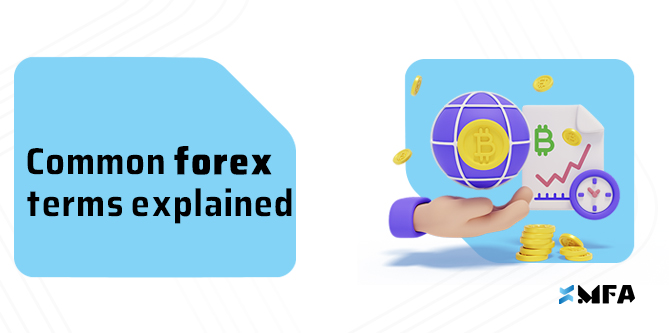Introduction | Know the Language, Trade with Confidence
Every market has its own language — and Forex is no different.
Words like pip, margin call, lot size, or scalping may sound technical at first,
but once you understand them, you’ll trade smarter and communicate like a pro.
This MFA Signals glossary breaks down over 20 essential Forex terms with simple explanations and real-world examples — perfect for beginner traders.
Section 1: Core Forex Concepts
1. Currency Pair
Two currencies traded together. You buy one and sell the other.
Example: EUR/USD = buying euros, selling dollars
2. Base & Quote Currency
• Base = first in the pair
• Quote = second
Example: USD/JPY → USD = base, JPY = quote
3. Pip (Point in Percentage)
Smallest unit of price movement
Example: EUR/USD from 1.1000 to 1.1010 = 10 pips gained
4. Spread
The difference between Ask and Bid (built-in trade cost)
Lower spread = lower trading fee
5. Leverage
Allows bigger trades with small capital
Example: $100 with 1:500 leverage = $50,000 position
Section 2: Account & Margin Management
6. Balance
Account value without open trades
7. Equity
Balance + current profit/loss
Example: $1,000 balance + $50 floating profit = $1,050 equity
8. Margin
The capital locked by broker to maintain an open trade
9. Free Margin
How much money is still available to open more trades
10. Margin Call
Warning from your broker if your equity drops too low → trades may close
Section 3: Trade Size & Orders
11. Lot Size
| Lot Type | Size (Base Units) |
| Standard Lot | 100,000 |
| Mini Lot | 10,000 |
| Micro Lot | 1,000 |
| Nano Lot | 100 |
12. Take Profit & Stop Loss (TP / SL)
• TP: closes trade with profit
• SL: cuts loss at a predefined point
MFA Signals always provide TP/SL in every trade setup
13. Market vs. Pending Orders
• Market: Instant execution
• Pending: Executes when a set price is reached
Section 4: Trading Styles & Tools
14. Scalping
Very short trades for quick profits (5–10 pips)
15. Swing Trading
Holding trades for hours or days to capture big moves
16. Hedging
Opening opposite positions to reduce risk
17. Backtesting
Testing a strategy on past market data
18. Forward Testing
Using a strategy live on demo or real account
Section 5: Technical & Fundamental Terms
19. Technical Analysis
Reading price charts, indicators, and trends to make trading decisions
→ MFA Signals rely heavily on technical setups
20. Fundamental Analysis
Studying economic data, interest rates, and news that affect markets
21. Indicators
Tools like RSI, MACD, Moving Average used in technical setups
22. Trend
The overall direction of the market (uptrend, downtrend, sideways)
Conclusion | Know the Terms, Trade Like a Pro
Understanding Forex terminology is like learning the grammar of a new language.
The more fluent you are, the better your trades and analysis will be.
At MFA Signals, we integrate these terms daily into real-time trading education and setups — helping you learn as you earn.
FAQs
Do I need to memorize all these terms?
Not at all! Just start by understanding them — with time and usage, they’ll become second nature.
How can I learn Forex terms faster?
Follow real signals like MFA, read glossaries like this, and apply what you learn in daily trades

